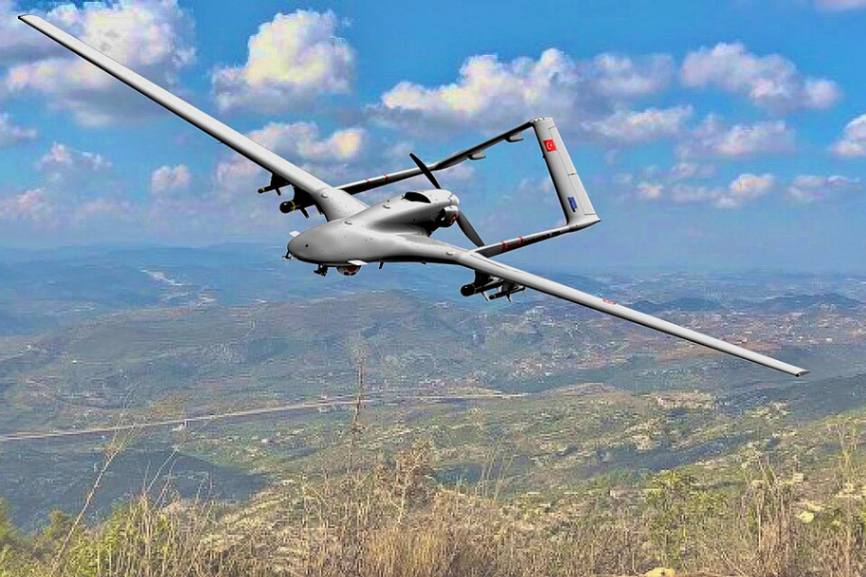Following April’s terrorist attack in Kashmir, perpetrated by The Resistance Front, India and Pakistan engaged in their most serious exchange of military strikes since the Kargil War in 1999. Back then, Pakistan had just carried out its first successful nuclear weapons test, raising the stakes of its decades-old feud with India to an existential level. Now, whilst nuclear concerns remain, the conflict has evolved once more, with drones utilized for the first time. Whereas much focus has been afforded to the Chinese military hardware deployed by Pakistan, less attention has been placed on the country’s drone fleet, which is overwhelmingly comprised of Turkish UAVs, including the Bayraktar TB2 drone. This development underscores a growing military partnership between Ankara and Islamabad that risks destabilizing regional flashpoints across the world, from South Asia to the Caucasus.
Since recording its first kill in April 2016, the Bayraktar TB2 drone has gained notoriety through its involvement in several geopolitical conflicts. The model featured prominently in the Second Nagorno-Karabakh War in 2020, in which Azerbaijan, backed by Turkey, launched an offensive against the autonomously governed, ethnic Armenian state of Artsakh inside its own borders. Despite falling short of its main objective, Baku enjoyed a significant military victory against Yerevan that Autumn, agreeing to a ceasefire that only postponed another Azeri invasion of the enclave until September 2023. A major contributor to this victory was the use of Turkish TB2 drones, which were able to overwhelm Armenian tanks, artillery, and missile defense systems, as well as relentlessly target Armenian soldiers in the trenches. These tactics, and the same drones, were subsequently adopted by the Ukrainian military following Russia’s invasion of the country, affording Ankara even more diplomatic importance and allowing it to support military operations against yet another regional adversary.
The Bayraktar TB2 is not the only Turkish drone model that Pakistan has integrated into its arsenal. In fact, Pakistan’s drone offensive against India, launched overnight between 8 and 9 May, featured nearly 400 Turkish-made SONGAR drones. Like the Bayraktar, the SONGAR is designed for armed operations rather than being limited to reconnaissance and intelligence gathering roles. However, the technical specifics of these models are less significant than the broader emergence of a Turkey-Pakistan axis. Through deeper military cooperation and particularly the use of Turkish-made drones, Islamabad is able to pursue a low-risk, low-casualty strategy to pressure New Delhi whilst remaining below the perceived threshold for nuclear escalation. Pakistan’s decision to retaliate using drones was largely perceived as a limited response to India’s Operation Sindoor.
For this, Azerbaijan’s victory over Armenia in 2020 has evidently provided a strategic model in Pakistan’s offensive against India. Just as Baku used Turkish drones to unilaterally force a resolution to a longstanding territorial dispute with its neighbors, Islamabad hoped to force a similar outcome with India through the same means. During the Second Nagorno-Karabakh war, Turkish drones were so crucial to Azerbaijan’s victory that the country’s president, Ilham Aliyev, singled the technology out for praise, adding that he hoped his own military could emulate the drone production capabilities of its longstanding allies. Armed with laser-guided smart munitions, the Bayraktar drones were able to evade Armenia’s Russian air defense systems, and destroy a substantial amount of the country’s defensive equipment and land forces. The Azeri military also adopted swarm tactics, deploying dozens of drones simultaneously in waves to overpower Armenian defenses.
Several years later, Pakistan is borrowing from the same playbook. Utilizing an inventory of over a thousand drones, the Pakistani military evidently considers this new technology, an essential element of its armed forces, incorporating Turkish, as well as Chinese and domestic platforms. Employing Turkish-made drones, in conjunction with missile strikes, Pakistan attempted to target several Indian military headquarters along the border between the two countries. However, Pakistani drones also appear to have targeted major cities, such as Amritsar, as well as places of worship, with a drone falling and injuring civilians near the Harmandir Sahib, the holiest site for Sikhs. In total, Pakistan is believed to have deployed nearly 400 drones in multiple waves over the course of two days. Although Pakistan was unable to follow its use of drones with further land or air attacks, the Azerbaijan example demonstrates how swarm attacks using drones can be used to precede more conventional military advances, once defense systems have been overwhelmed and neutralized. Thus, whilst drones are intended to avoid severe escalation, there was no guarantee in the immediate aftermath of these attacks, that the conflict was set to defuse any time soon.
Fortunately, the ceasefire that was brokered in the days that followed Pakistan’s drone onslaught prevented a nuclear escalation for now. Unfortunately for Pakistan, however, as the dust begins to settle on its attack, evidence suggests that this new tactic has not been as effective as Islamabad would have hoped. Whilst Pakistan declared it had destroyed defense systems, military bases, and artillery positions, India categorically denied any such claims, retorting that its missiles and air defenses had effectively neutralized Pakistani drones before they were able to deal any damage to critical Indian positions. This was corroborated by satellite imagery, which revealed largely contained damage. In fact, much of the damage was revealed to have been carried out by Indian strikes on Pakistani military bases, rather than the other way around.
Moving forward, Pakistan’s partnership with Turkey will only deepen in the coming years. The pair established the High Level Military Dialogue mechanism over two decades ago in 2003 and since then have enjoyed great cooperation in the military sphere. In 2021, Pakistan’s National Engineering and Science Commission signed an agreement with Turkish Aerospace Industries to co-produce Anka military drones in Pakistan; that same year suspicions also grew that Islamabad was aiding Ankara’s pursuit of nuclear weapons. Two years later, and in light of tense relations with the West, Pakistan looked towards Turkey as an alternative source of anti-tank weapons systems.
Things were no different at the start of this year, following the seventh round of the Pakistan-Turkey High-Level Strategic Cooperation Council. During the talks, Pakistani Prime Minister Shahbaz Sharif and Turkish President Recep Tayyip Erdogan reached several agreements, including strengthening collaboration on defense production and a pledge to increase bilateral trade, which will likely include the sale of military hardware from Turkey to Pakistan. Military support even stepped up in the days following the Pahalgam terrorist attack in Kashmir. Seemingly anticipating an Indian military response, Turkey began supplying Pakistan with arms and munition, with six C-130 carbo planes arriving at a military base in Islamabad on 28 April. Local media has also reported that two Turkish drone operators were killed during India’s Operation Sindoor, suggesting even greater involvement from Ankara than first anticipated.
In the days and weeks since this latest flare up in South Asia, Turkey has been on the receiving end of a boycott campaign across various sectors of Indian society, including in academia, where several Indian universities severed ties with their Turkish counterparts. More significantly, on 15 May New Delhi revoked the security clearance of Turkish aerospace company Celebi Aviation, which had until now been responsible for providing vital services at airports throughout India. Even before May’s exchange of missile and drone attacks, relations between India and Turkey had not been in the ascendancy. Against the backdrop of growing ties between Ankara and Islamabad, New Delhi had been providing tangible support for Armenia in its defense against Turkish-backed Azeri aggression. Now, however, the lines in the sand are more defined than ever and the increased use of drone warfare is driving a fresh arms race. As one of the world’s leading producers of combat drones, all eyes will be on Turkey and who Erdogan chooses to do business with. As the case of Pakistan has shown at the start of May, the stakes could not be higher.
[Photo by Army.com.ua, CC BY 4.0, via Wikimedia Common]
The views expressed in this article are those of the author and do not necessarily reflect TGP’s editorial stance.

Marcus Andreopoulos is a Senior Research Fellow at the international policy assessment group, the Asia-Pacific Foundation, and a Subject Matter Expert with the Global Threats Advisory Group at NATO’s Defence Education Enhancement Programme. Marcus is currently pursuing a PhD in international history at the London School of Economics and Political Science (LSE).

